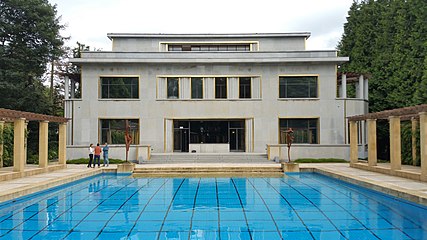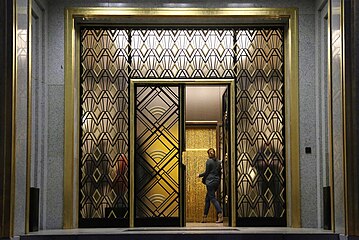Villa Empain
| Villa Empain | |
|---|---|
 The Villa Empain seen from the Avenue Franklin Roosevelt/Franklin Rooseveltlaan | |
 | |
| Alternative names | Villa Roosevelt |
| General information | |
| Type | Private house |
| Architectural style | Art Deco |
| Address | Avenue Franklin Roosevelt / Franklin Rooseveltlaan 67 |
| Town or city | 1050 Ixelles, Brussels-Capital Region |
| Country | Belgium |
| Coordinates | 50°48′26.94″N 4°23′3.12″E / 50.8074833°N 4.3842000°E |
| Construction started | 1930 |
| Completed | 1934 |
| Renovated | 2009–2010 |
| Client | Louis Empain |
| Owner | Boghossian Foundation |
| Technical details | |
| Floor area | 2,500 m2 (27,000 sq ft) |
| Design and construction | |
| Architect(s) | Michel Polak |
| Renovating team | |
| Architect(s) | Francis Metzger |
| Renovating firm | Metzger et Associés Architecture |
| Website | |
| Official website | |
| References | |
| [1] | |
The Villa Empain is a former private residence in Brussels, Belgium, which currently serves as a cultural centre and exhibition space. Built in 1930–1934 in Art Deco style by the Swiss-Belgian architect Michel Polak, the villa was commissioned by Baron Louis Empain, son of the industrialist Édouard Empain. It subsequently served as offices and an embassy before falling into disuse. After a restoration from 2009 to 2011, it was opened to the public by the Boghossian Foundation.
History
[edit]Design and construction
[edit]Baron Louis Empain (1908–1976) was the second son of Édouard Empain (1852–1929), a respected Belgian industrialist who had spent much of his career in Egypt. In 1930, Louis commissioned the Swiss-Belgian architect Michel Polak to build a large house in Art Deco style on the edge of the Bois de la Cambre/Ter Kamerenbos, in the emerging southern suburbs of Brussels, on what was then known as the Avenue des Nations/Natiënlaan (now the Avenue Franklin Roosevelt/Franklin Rooseveltlaan).
Built between 1930 and 1934, the Villa Empain is organised around a large enclosed courtyard. It was designed in Art Deco style, and the project aroused significant interest in Belgium where prestigious houses in the style were comparatively rare.[1] Various expensive stone facings were used from around the world.
Later history
[edit]Despite the expense incurred in construction, Louis Empain barely used the house after its completion and lived primarily in Canada. In 1937, it was donated to the Belgian State to house a museum of applied arts for the École nationale supérieure d'Architecture et des Arts décoratifs de La Cambre. It was requisitioned by the German Army in November 1943 during the occupation.[1]
After the war, the Villa Empain was ceded to the Soviet Union as an embassy at the initiative of Paul-Henri Spaak. Disapproving of this use, it was reacquired by the Empain family in 1963 and resold in 1973 to Harry Tcherkezian, an Armenian-American tobacco entrepreneur.[1] It was used by Radio-Télévision-Luxembourg (RTL) from 1980 to 1993, before becoming unoccupied after 1995. The building was classified in 2007, but its condition degraded significantly.[1]
In 2007, the Villa Empain was acquired by the Boghossian Foundation.[1] It was restored between 2009 and 2010 and reopened to the public as a museum and cultural centre. The conservation project was awarded the European Union Prize for Cultural Heritage / Europa Nostra Award in 2011.
-
Rear of the Villa Empain, showing the large original swimming pool
-
Entrance
-
Main hall
Exhibitions
[edit]- Colors of the Orient, Arts and lifestyles in the Ottoman Empire (2010)
- Of women's modesty and anger (2011)[2]
- A dream of eternity. The long road of Oriental arts (2011)
- Art is the answer! Contemporary Lebanese artists and designers (2012)
- Edouard and Cleopatra. Egyptomania's from the XIXth century (2012)
- Turbulences II (2013)[3]
- Abandoned Dwellings of Beirut by Gregory Buchakjian (2019)[4]
See also
[edit]- Stoclet Palace
- List of museums in Brussels
- Art Deco in Brussels
- History of Brussels
- Culture of Belgium
References
[edit]- ^ a b c d e f Région de Bruxelles-Capitale (2007). "Hôtel Empain". Inventaire du patrimoine architectural (in French). Brussels. Retrieved 23 April 2010.
- ^ "Pudeurs et colères de femmes". Exponaute. Retrieved 29 September 2012.
- ^ "Turbulences II". Undo.net. 28 February 2013. Retrieved 2 March 2013.
- ^ Cornwell, Tim (9 December 2019). "Houses of memory: Inside the abandoned buildings of Beirut". Middle East Eye. Retrieved 4 July 2020.
Further reading
[edit]- Roset, C. (1935). "L'hôtel particulier du baron Louis Empain, avenue des Nations, à Bruxelles". La Technique des Travaux (in French). 8. Brussels: 394–401.
- Flouquet, P.-L. (1938). "Une perle fausse. L'avenue des Nations". Bâtir (in French). 67: 251–252.
- Maillard, R. (1935). "L'hôtel du baron Louis Empain". Clarté (in French). 8: 1–6.
- Duquesne, S. (1996). "De residentie van Baron Louis Empain". M&L: Het Tijdschrift voor Monumenten, Landschappen en Archeologie (in Dutch). 2: 6–20.
- (in French) Carlo R. Chapelle, La Voie lactée ou quelques notes concernant l'hôtel Empain, Bruxelles, 2007 ].
External links
[edit] Media related to Villa Empain at Wikimedia Commons
Media related to Villa Empain at Wikimedia Commons- Official website



